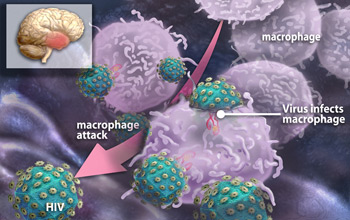|

Press Release 05-172
Autoimmune Overload May Damage HIV-Infected Brain

White blood cells may be cause of dementia in people with AIDS
September 27, 2005
Researchers studying the evolution of the human immunodeficiency virus (HIV) in the brain have found that the body's own defenses may cause HIV-related dementia.
Publishing in the Sept. 2005 issue of the Journal of Virology, the researchers show that HIV in the temporal lobe mutates at a rate 100 times faster than in other parts of the body, triggering white blood cells to continually swarm to attack the infection. The associated overcrowding and inflammation appear to cause the dementia.
Earlier studies had suggested that the build-up of white blood cells could lead to HIV-related dementia, but this is the first study to track the probable mechanism.
The findings could lead to new treatments that target HIV-infected white blood cells, perhaps one day countering the brain wasting that will affect as many as 15 percent of the nearly 40 million people around the world who are infected with the virus.
The study is a collaboration among researchers at the University of California at Irvine, the University of Florida at Gainesville, Gene Johnson, Inc., of St. Augustine, Fla., the University of California at San Francisco (UCSF) and the University of Oxford in the United Kingdom.
One of the critical tools behind the discovery is HIVBase, a genetic data-storage and -analysis tool with which the researchers tracked the rapidly evolving viruses. Gene Johnson developed the tool with the support of an NSF Small Business Innovation Research award.
According to co-author Susanna Lamers of Gene Johnson and UCSF, the results strengthen an earlier hypothesis by Kenneth Williams of Harvard University and William Hickey of Dartmouth Medical School. They had suggested that the continual build-up of white blood cells in the brain could lead to HIV-associated dementia.
"In our work," says Lamers, "we conducted a thorough examination of HIV genetic sequences and were able to prove that the researchers’ concept was a good explanation for both clinical latency—when the body mounts a strong immune defense and the number of viral particles decreases—and the long-term damage associated with HIV infection in the brain. They offered the model, we provided strong evidence that the model is accurate."
Additional information is available in press releases from the University of Florida and Gene Johnson.
-NSF-

Media Contacts
Joshua A. Chamot, NSF (703) 292-7730 jchamot@nsf.gov
April Frawley Birdwell, University of Florida Health Science Center (352) 273-5817 afrawley@vpha.health.ufl.edu
Jeff Sheehy, University of California, San Francisco, AIDS Research Institute (415) 597-8165 JSheehy@ari.ucsf.edu
Program Contacts
Errol B. Arkilic, NSF (703) 292-8095 earkilic@nsf.gov
Principal Investigators
Susanna Lamers, Gene Johnson, Inc. and the University of California, San Francisco (985) 493-3487 susanna@genejohnson.net
Related Websites
Gene Johnson, Inc. Press Release: http://www.hivbase.com
University of Florida Press Release: http://www.news.health.ufl.edu/story.asp?ID=2097

The National Science Foundation (NSF) is an independent federal agency that
supports fundamental research and education across all fields of science and
engineering, with an annual budget of $6.06 billion. NSF funds reach all 50
states through grants to over 1,900 universities and institutions. Each year,
NSF receives about 45,000 competitive requests for funding, and makes over
11,500 new funding awards. NSF also awards over $400 million in
professional and service contracts yearly.
 Get News Updates by Email Get News Updates by Email
Useful NSF Web Sites:
NSF Home Page: http://www.nsf.gov
NSF News: http://www.nsf.gov/news/
For the News Media: http://www.nsf.gov/news/newsroom.jsp
Science and Engineering Statistics: http://www.nsf.gov/statistics/
Awards Searches: http://www.nsf.gov/awardsearch/
| 



